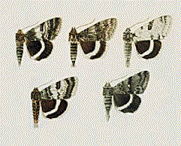Papers in the Biological Sciences

Alan Bond Publications
Document Type
Article
Date of this Version
1982
Abstract
Subjects were presented with a collection of spherical beads of four different colors and were instructed to sort them as fast and as accurately as possible. The sequence in which the beads were sorted was recorded, along with the time intervals between successive beads. Subjects were observed to sort in nonrandom sequences, producing runs in which a given bead type was taken exclusively. The speed and accuracy of the sorting process was positively correlated with the degree of nonrandomness of the sorting sequence. This relationship appeared to be primarily attributable to perceptual factors involved in the initiation of a run and secondarily attributable to facilitation of sorting movements within runs. The effect of sorting sequence was enhanced with bead colors that were harder to discriminate. The results are interpreted in the light of known effects of presentation sequence and stimulus discriminability on stimulus processing.


Comments
Published in Human Factors 24:1 (1982), pp. 101–110. Copyright 1982 The Human Factors Society, Inc.; published by Sage Publications. Used by permission.